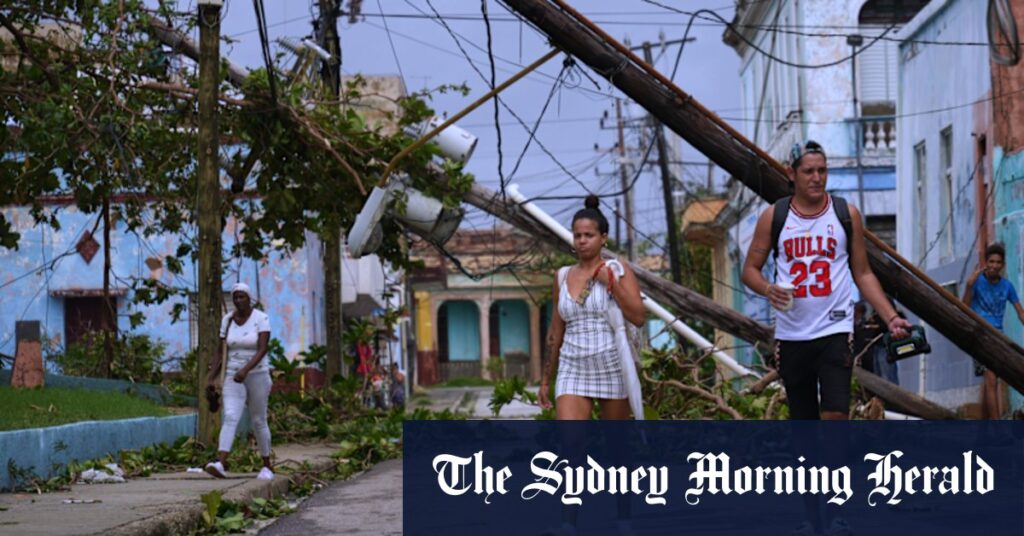
Santiago de Cuba: Satellite images have revealed widespread devastation across Jamaica following Hurricane Melissa, which ravaged the Caribbean island yesterday. The catastrophic storm left dozens dead and caused significant destruction across Cuba, Haiti, and Jamaica, with roofless homes, fallen utility poles, and water-logged furniture painting a grim picture of the aftermath.
A landslide blocked the main roads of Santa Cruz in Jamaica’s St Elizabeth parish, transforming streets into mud pits. Residents scrambled to sweep water from their homes, attempting to salvage what belongings they could. Winds ripped off part of the roof at a high school, which had been designated as a public shelter. “I’ve never seen anything like this before in all my years living here,” said resident Jennifer Small, capturing the shock felt by many.
Hurricane Melissa’s Path of Destruction
Melissa made landfall on Tuesday in Jamaica as a catastrophic Category 5 storm with top winds of 295 km/h, marking it as one of the strongest Atlantic hurricanes on record. Although it weakened as it moved on to Cuba, the storm’s massive scale meant that even countries outside its direct path felt its devastating effects.
In Haiti, the storm’s flooding claimed at least 25 lives in the southern coastal town of Petit-Goave, according to Mayor Jean Bertrand Subrème. The La Digue River burst its banks, causing dozens of homes to collapse and leaving people trapped under rubble. The situation was dire, with only one official from Haiti’s Civil Protection Agency present to aid in evacuations amid the heavy floodwaters.
Meanwhile, in Cuba, officials reported collapsed houses, blocked mountain roads, and roofs blown off buildings on Wednesday. The heaviest destruction was concentrated in the southwest and northwest regions, with approximately 735,000 people taking refuge in shelters. “That was hell. All night long, it was terrible,” recounted Reinaldo Charon from Santiago de Cuba, as he ventured out into the rain, shielded by a plastic sheet.
Jamaica Faces Economic and Humanitarian Crisis
In Jamaica, more than 25,000 people sought refuge in shelters on Wednesday, with numbers increasing as the day progressed. The storm left a significant portion of the population temporarily homeless after ripping roofs off homes. Dana Morris Dixon, Jamaica’s education minister, reported that 77 percent of the island was without power on Wednesday, complicating recovery efforts.
Jamaica’s economic losses could reach nearly $8 billion, according to Chuck Watson, a disaster modeller at Enki Research. This figure represents about 35 percent of the island’s GDP. “It was widespread destruction,” Watson told Bloomberg, noting that the damage exceeded the $6 billion toll from Hurricane Gilbert in 1988. “This was a very slow, very wet storm,” he added, explaining that a faster-moving storm might have caused less damage.
“It’s not going to be an easy road,” said Desmond McKenzie, deputy chairperson of Jamaica’s Disaster Risk Management Council.
Amidst the chaos, at least one death was reported in the country’s west when a tree fell on a baby, state minister Abka Fitz-Henley informed the Nationwide News Network. Prime Minister Andrew Holness addressed the nation, assuring Jamaicans, especially those in the hardest-hit areas, that the government was actively working to provide assistance. “We know many of you are hurting, uncertain and anxious after Hurricane Melissa, but please know that you are not alone,” he stated. “Our teams are on the ground working tirelessly to rescue, restore, and bring relief where it’s needed most.”
In the southwest, 84-year-old David Muschette sat amidst the rubble of his roofless house, having lost everything. “I need help,” he pleaded, pointing to his wet clothes and furniture scattered outside.
The Jamaican government aims to reopen all airports by Thursday to facilitate the rapid distribution of emergency relief supplies. The United States is also sending rescue and response teams to assist in recovery efforts across the Caribbean, as announced by Secretary of State Marco Rubio. Coordination is underway with leadership in Jamaica, Haiti, the Dominican Republic, and the Bahamas.
Cuba’s Struggle and Resilience
In Santiago de Cuba province, residents began clearing debris from their homes after Hurricane Melissa made landfall. “Life is what matters,” said Alexis Ramos, a 54-year-old fisherman, as he surveyed his destroyed home, protected from the rain by a yellow raincoat. “Repairing this costs money, a lot of money.”
Local media reported severe damage to the Juan Bruno Zayas Clinical Hospital, with glass scattered across floors and waiting rooms in ruins. In Granma province, particularly in Jiguani, parts were submerged under water, with more than 40 centimeters of rain reported in the settlement of Charco Redondo.
“There will be a lot of work to do. We know there will be a lot of damage,” Cuban President Miguel Díaz-Canel said in a televised address.
The hurricane’s impact could exacerbate Cuba’s ongoing economic crisis, which has already led to prolonged power blackouts and shortages of fuel and food. As of Thursday morning, the storm was located 130 kilometers southeast of the central Bahamas, moving northeast at 26 km/h, according to the US National Hurricane Center (NHC). Melissa’s maximum sustained winds were 150 km/h, classifying it as a Category 1 storm.
The storm began affecting the southeastern Bahamas on Thursday morning, where authorities were evacuating residents ahead of its arrival. Melissa’s center is expected to move through the southeastern Bahamas, generating up to 2 meters of storm surge in the area, before passing just west of Bermuda.
The Caribbean faces a long road to recovery, with communities rallying together to rebuild amidst the devastation left by Hurricane Melissa. As nations work to restore normalcy, the resilience of the affected populations remains a testament to their enduring spirit in the face of natural disasters.







